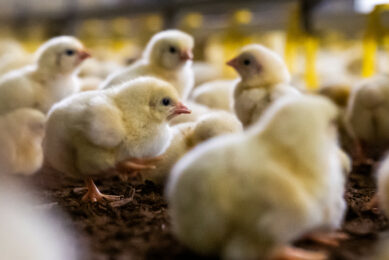Bridging the protein gap with resilient animals

Resilient animals that can handle infections better reduces the need for treatment. The key to animal resiliency is understanding the role of the gut in immune function and improve the gut function. Here we explain how Refined Functional Carbohydrates can help in doing so.
Converging global trends are triggering unprecedented growth in the world’s livestock industries. While world population continues to grow, incomes are rising as well. With higher income, people seek improved diets and increasingly turn to high-value nutrition and flavour from meat, eggs, milk and other dairy products. This rising protein demand creates extraordinary opportunities for livestock and poultry producers around the world.
By 2030, the World Health Organization (WHO) projects annual meat production to reach 376 million tons globally – up from 218 million tons in 1997-19991. Although these trends are great news for the livestock industry, there are challenges abound. Surging demand creates greater pressure to produce protein sustainably with less environmental impact. Producers must achieve highly efficient livestock growth and optimise animal health in the face of environmental, management, animal welfare, labour and facility challenges. And, they must control a myriad of diseases, including those caused by bacterial infections. Meanwhile, changing consumer preferences and government regulations in many regions increasingly limits the use of antibiotics, requiring producers to adjust treatment protocols to control harmful pathogens. Livestock and poultry producers increasingly turn to proactive approaches to make animals more resilient to environmental pathogens and other challenges without antibiotic intervention. Reducing the dependency on (preventive) and overuse of antibiotics can be done via disease prevention programmes, farm hygiene, the use of certain nutritional and feed additive tools, optimised farm management and making the animals more immune and stronger. Having more resilient animals not only means they are healthier and need less antibiotics, they can recover quicker after they catch an infection. This is better for animal welfare and health and can save the farmer money.
Creating resilient animals and birds
The key to animal resilience is understanding the role of the gut in immune function. The gut is the primary point of attack by invading pathogens such as E. coli, or Salmonella, by feed-associated mycotoxins or by other pathogens in the animal’s body. When gut immunity falters, animals become more susceptible to a wide range of diseases. Maintaining a healthy gut allows proper feed digestion and nutrient absorption and prevents the energy drain caused by unnecessary immune responses so animals can maintain health and performance. Therefore, the gut lining is a strategic opportunity for livestock and poultry producers to provide real time protection and reduce the risk of disease-causing pathogens and toxins entering the animal’s system. By managing these challenges proactively and effectively in the gut, producers may be able to enhance animal health and performance and reduce the need for antibiotic treatments.
Feeding for resiliency
There is growing interest in nutritional approaches to enhance gut health for better immune response. Certain feed additives help maintain a healthy gut by managing the natural microbial populations and immune response in the digestive system. These dietary ingredients can prepare animals’ immune systems ahead of challenges, so they are better able to mount effective responses. For example, multiple research studies demonstrate that feeding the Refined Functional Carbohydrates™ (RFCs™) found in a commercial product* can help provide a healthy base for animal growth and development, leading to improved animal productivity. RFCs work by supporting the beneficial bacteria found in the intestine while blocking sites for attachment by certain pathogens2,3. These ingredients also support optimal rumen fermentation and digestion and reduce the effects of toxins, such as mycotoxins, in feed4,5. RFCs are the components harvested from yeast cells (S. cerevisiae) using specific enzymes during a proprietary manufacturing process. Each component has a specific mode of action and outcome when fed to animals.
- MOS (Mannan Oligosaccharides) support consistent growth of beneficial bacteria such as Lactobacillus and Bifidobacterium
- Beta 1,3-1,6 glucans help support the immune system and bind mycotoxins, which provides protection to intestinal cells
- D-Mannose binds pathogenic bacteria such as E. coli and Salmonella
- Other RFCs help prevent certain protozoa like Eimeria (coccidiosis) and Cryptosporidium from attaching to the intestinal wall and causing disease
Benefits of better gut health
Research shows that feeding RFCs can make poultry more resilient under stressful conditions, leading to better feed efficiency and performance. Both layers and broilers benefit from improved gut health. In a commercial layer trial6 involving four houses with 60,000 to 90,000 hens per house, feeding RFCs improved egg performance while reducing mortality and Salmonella prevalence (Table 1 and 2).
An economic analysis demonstrated that these results had potential to add US$ 0.60 (€ 0.53) in revenue per hen housed. Research shows that supplementation of broiler diets with RFCs effectively enhances bird performance, improving weight gain and feed conversion, and improving uniformity of bird size and weight at slaughter. A study with 1,600 day-old chicks7 compared the effect of RFCs on performance of birds raised under standard coccidiosis management programs. Adding RFCs to diets improved performance of birds vaccinated for coccidiosis as well as those fed a coccidiostat (Figure 1).
Dairy herd resiliency
Dairy animals also are vulnerable to a host of stresses and pathogens that can overcome the immune system, especially early in life and during transition following calving. A study on 2 commercial US farms8 compared health and performance of milk-fed Holstein calves supplemented with RFCs. Researchers studied overall health, faecal pathogen shedding and average daily gain of 319 3-day-old calves in individual housing for days one through 6, and group pens with automatic feeders until day 56. Calves fed RFCs had lower probability of developing severe diarrhoea and had less shedding of Salmonella and rotavirus pathogens. Improved gut health led to improved growth and performance, with calves fed RFCs recording 2.1kg higher body weights at the end of the trial compared with controls without RFC supplementation. The importance of supporting immunity through nutrition continues throughout a dairy animal’s life, especially the critical transition period. A poorly functioning immune system allows opportunistic pathogens to colonise and cause disease9. Feeding RFCs helps support and enhance the cow’s immune system during transition and beyond.
Also read: “EU status of CRISPR-Cas is outrageous”
Comparing results with ZnO
As with young calves, weaning is a stressful time for pigs. Antibiotics and zinc oxide (ZnO) are common solutions to alleviate stress at this stage. Pressure is increasing around the world to reduce or eliminate antibiotics and ZnO in feeds. Research shows that RFCs may provide a viable alternative to maintain piglet health through better gut health. On a commercial sow farm10, RFC supplementation in sow lactation diets resulted in improved piglet weaning weights, compared to control sows without RFCs (Table 3). Piglets from RFC-fed sows sustained their body weight (BW) advantage through the end of the nursery phase – with weights comparable to nursery pigs fed ZnO.
Conclusion
In conclusion, maintaining gut health through proper nutrition can make animals more resilient to pathogenic bacteria and other challenges. Feeding RFCs can help maintain gut health to create optimal immunity through every bite of feed, decreasing dependency on antibiotics or other interventions.
* CELMANAX™ (Arm & Hammer Animal and Food Production)
References 1-10 are available on request.












